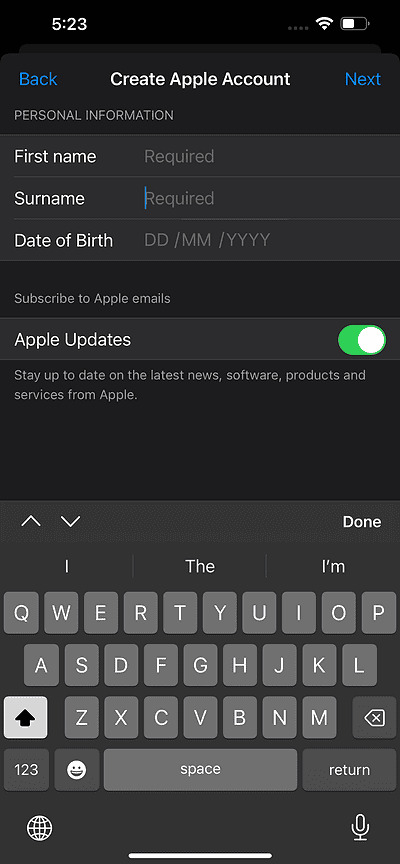When creating a new Apple account, you’ll often need to enter a verification code sent via SMS for security purposes. The process generally works fine. However, you might sometimes encounter an error message saying that the verification failed because the code could not be sent to the provided phone number.
That said, you can still proceed with account creation. Here’s what to do.
How Do I Fix “Verification Failed Could Not Send Code to Phone Number”?
1. Create an Apple Account via the App Store
Time needed: 5 minutes
The most effective troubleshooting solution is to create an Apple Account (formerly known as Apple ID) through the App Store. Just follow these steps:
- Open the App Store and click the blue My Account icon in the top right corner.
- Tap the Create New Apple ID option.
- Now, enter a strong password twice, along with your region. Also, toggle on the switch next to Agree to Terms and Conditions.
- On the next screen, enter your First Name, Surname, and Date of Birth. Then, tap Next.
- Next, enter your payment information. This isn’t a necessary step, and can be skipped by choosing None.
- Finally, enter a phone number that can be used to verify your identity. Hopefully, a verification code will be sent to your number for confirmation now.
2. Create a New Apple Account From the Settings App
Instead of creating your new Apple account through Apple’s iCloud website or the App Store, we recommend creating one through the Settings app. Here’s what you need to do:
- Open Settings and tap the Sign in to your iPhone option on the top.
- Tap “Don’t have an Apple ID?”.
- Follow the on-screen instructions like entering your name and date of birth.
- Enter an Email Address that will become your Apple ID. If you don’t have an email address, you can tap Do not have an email address? tocreate an iCloud email address as well.
- Now, enter a strong password for your Apple ID.
- Choose your region, and enter your phone number to receive a verification code. Then, tap Continue.
You can also choose to verify your identity via a phone call. Be sure to try that as well.
3. Create an Apple Account via the Mail App
One more option is to create an iCloud email address through the Mail App and then use it to create an Apple Account via iCloud’s website, Settings app, or the App Store. Here’s what you need to do:
- Open the Mail app.
- You’ll see many different options on the screen including iCloud, Microsoft Exchange, Google, Yahoo, AOL, and Outlook. Select iCloud.
- Tap Create a new iCloud Mail Account.
- Enter your email address.
- Tap Continue, and then tap the Confirm Email Address button.
- Tap Done.
Once the Mail app is done setting up your account, use it to create an Apple Account using iCloud’s website, or any of the options above.
4. Reset Your Time and Date to 24 Hour Clock
Resetting your date and time to a 24-hour clock might resolve the issue, as time discrepancies can sometimes cause the system to detect your location incorrectly. All you need to do is go to Settings > General > Date & Time. Now, toggle on the switch next to 24-Hour Time.

Including this, we also recommend that you toggle off the switch next to Set Automatically for a few seconds, switch to any other time zone, and then toggle it on again. After all these steps, you can try the verification step again, and it might work.
5. Check Your Internet Connection
In most cases, the root cause is usually a poor internet connection. Therefore, to ensure you are connected to a secure and strong network, we suggest that you reboot your wireless router, disconnect the Wi-Fi from your iPhone, choose Forget Password and connect to it again. If it still doesn’t work, try shifting to a cellular data network.
6. Reset All Settings on Your iPhone
Another way to prevent the “Verification Failed, code not sending” message is to reset all settings on your iPhone. Go to Settings > General > Transfer or Reset iPhone > Reset > Reset All Settings. Don’t worry; this is different than factory resetting your iPhone. All this will do is reset your iPhone’s settings to their default.

Now, try creating an Apple Account again.
7. Request Account Recovery
If nothing works and you have an existing Apple Account that you can’t verify, you can try to request Account Recovery from Apple. Even Apple itself recommends using account recovery as your last resort.
This is because it takes longer than just a few days to get your account back in use which becomes inconvenient for many users. You can submit an account recovery request by emailing iforgot.apple.com. Keep in mind that this won’t work if you’re trying to create a new Apple Account.
8. Contact Apple Support
Should issues persist, the last resort is to contact Apple Support. Go to Apple’s support website, and tap on Start your support request online. In the search bar, enter your problem like “Verification failure.” A few solutions and articles will appear on the screen. You need to scroll down to the Contact part and choose Call Us. An Apple Support number will appear which you can contact to discuss the problem you are facing.
We suggest trying the solutions listed at the beginning of this article first. If nothing works, consider Apple Account recovery or contacting Apple Support.





